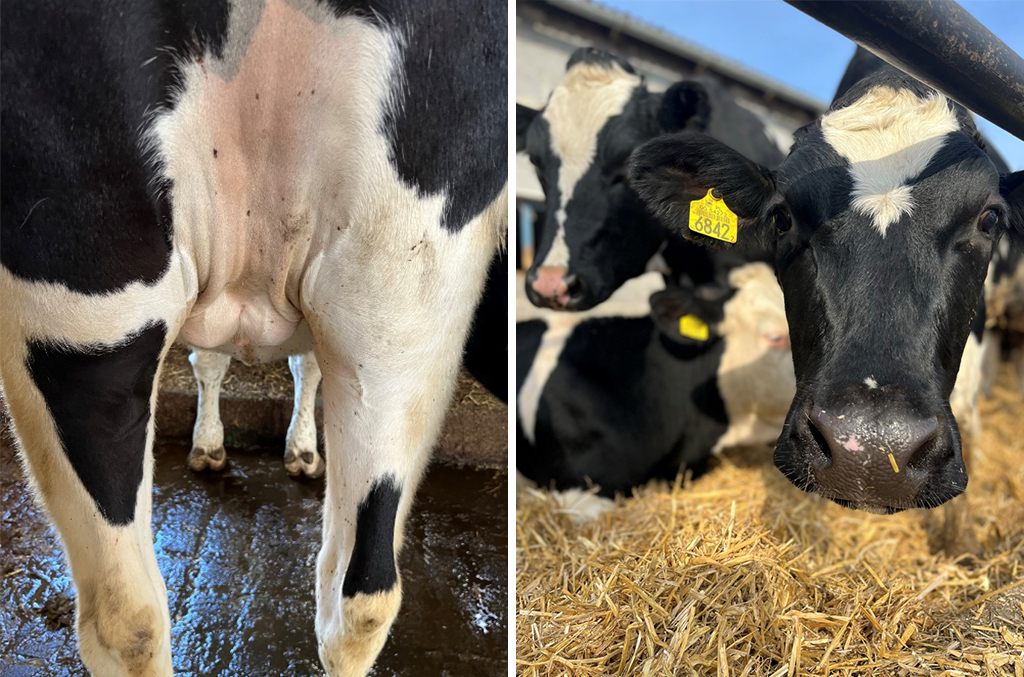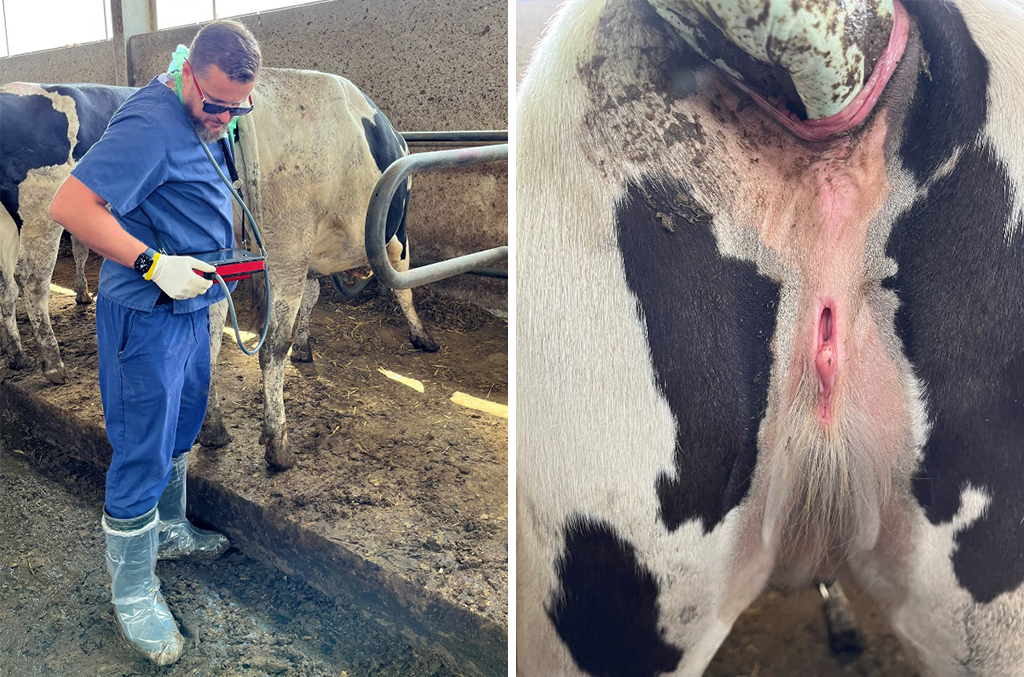Through the eyes of a veterinarian: HEIFERS

Heifers are growing animals aged between 6 months and 18-24 months, until their first calving. Just like calves, they are the future of every farm, but often after weaning, they are treated as secondary, while this group, in the phase of intensive growth, deserves equal attention. Do we realise that heifers are the potential for farm development, and thus improvement of its economy? Do we know that all the investment put into raising a calf and its genetic potential can be wasted if it is not properly raised as a heifer?
What does a veterinarian like me pay attention to during an audit on a farm in the context of heifer rearing?
1) Living conditions
After calves finish the milk feeding phase, they are usually placed in group pens and are forgotten about until the moment of breeding. The sight of heifers in cramped and stuffy spaces, without access to the outdoors, is unfortunately common in Polish farms.
Why are such conditions bad?
Heifers, due to the high density, are constantly exposed to stress, which can lead to lowered immunity, impaired bodily functions, and increased susceptibility to diseases. Moreover, the lack of sunlight has a very negative effect on their reproductive cycle, resulting in a lack of oestrus in animals that should begin reproductive periods around the age of 13 months. In my reproductive checks, I often find heifers suffering from ovarian dysfunctions which have been healing for a very long time.
So how should we raise heifers?
Many breeders ensure that this production group has access to outdoor runs, even if muddy. They are separated into pens depending on age or stage of pregnancy. I also often come across specially constructed heifer barns designed only for this group of animals.

2) Feeding
I leave the matter of feeding heifers, selecting the feed, and balancing rations to qualified nutrition advisors who know how to do it so that the heifer grows upward, not sideways. Issues such as: the same ration for all heifer groups, feeding leftovers from dairy cows, or feeding lower-quality feed all affect the development and health of our future cows. Remember, after all, the udders of our heifers are still developing!
For me, as a veterinarian, it is crucial to pay attention to whether we have overweight heifers in the herd.
An overweight heifer means nothing but problems, period. Why?
1. It is difficult to inseminate it because excess fat can cause oestrus disturbances.
2. Excessive fat around the hindquarters can cause calving difficulties.
3. The risk of postpartum diseases increases, such as ketosis, retention of the placenta, and displaced abomasum.
3) Prevention
Heifers are a particularly high-risk group. Due to stress related to their housing, frequent changes in groups, food rations, and the fact that in recent years, the import of heifers into Poland has increased, they are especially vulnerable and sensitive to infections.
One way to protect our heifers is to implement a well-designed vaccination programme.
Vaccination schedules depend largely on the status of the herd and the vaccines used, but generally, heifers are vaccinated against diseases such as BVD, IBR, and Q fever. Depending on the situation on the farm, vaccinations against chlamydia, agents causing diarrhoea in calves, pneumonia, and anaerobic bacteria should also be introduced if necessary.
However, it happens that breeders often forget about vaccinating their heifers. Why is that?
The vaccinations we give to heifers are typically administered to cows during their dry period, and as we know, heifers do not have this period. Therefore, when organising work on the farm and planning prevention, heifer vaccinations are often simply forgotten. We can avoid this problem by keeping track of the calving schedule. The tasks in the herd should be organised in such a manner that, depending on the programme, we can carry out the last vaccination about 2 weeks before calving. This is important because at this time we will have full-quality immunoglobulins in the colostrum.

4) Mastitis in heifers?
Mastitis can also occur before the first calving.
One cause is mutual sucking among calves in group pens. The sucking reflex can be satisfied in various ways, such as using slow-flow nipples, placing (disinfected and cleaned!) rubber teats in the pens, or providing water with a nipple, etc.
The problem of mutual sucking among calves is significant. On the one hand, we want the calves to be raised in groups for their well-being, but on the other hand, some of them suck on each other, causing inflammation in the still-developing udders, which can disqualify a heifer from further breeding. The result of such observation may occur as an inflammation of heifers prior to calving, or mastitis in the first-calver immediately after calving.
Another important factor contributing to mastitis in heifers and first-calvers is feeding them milk from non-classified cows. This is the least economical action I know, because while it seems that we are saving on milk, we are actually harming the animal, and consequently, ourselves. It has been proven that antibiotic residues can negatively affect the gut flora of calves, and pathogens in the milk can pass through lymphatic organs to, for example, the udder. Such calves, later as cows, have chronic mastitis and antibiotic resistance, making their treatment either impossible or very time-consuming, and certainly expensive!
5) Reproduction of heifers
For me, the only correct approach is to supervise the reproduction of heifers just as carefully as the reproduction of cows.
In my daily reproductive work with heifers, I primarily rely on hormonal programmes tailored to the specific herd. After the heifer reaches the appropriate weight and size, we perform the first ultrasound examination and introduce the animal into the programme. When it comes to artificial insemination, there are various effective breeding methods. Often, we rely on oestrus observation, but the success of this method depends on the human factor, which unfortunately often fails.
After insemination, the first pregnancy check is done on days 26-30, and then confirmed again in the third month.

In some farms, heifers are naturally inseminated, but even here, it can be done properly. The bull walking among the heifers must be separated from the group for 26 days. After that, we check the heifers from this group for pregnancy and separate the pregnant ones into a separate group. Non-pregnant heifers are treated hormonally and reintroduced to the bull.
We should not neglect heifer reproduction because it is key to rebuilding the herd, especially when using mostly sexed semen for insemination.
Sexed semen is also an effective method of preventing freemartinism among our heifers. Freemartinism refers to infertility in a heifer born from a mixed twin pregnancy. A freemartin heifer has underdeveloped or completely absent reproductive organs, while the male twin is typically fertile. There are cases where a freemartin heifer is born as a single calf after its twin brother died in the foetal stage. Regardless of the origin of such an animal, we lose a heifer that is incapable of reproduction. I encounter this phenomenon regularly in my practice, and I consider it a breeding problem, especially common in smaller, family-run farms.
In conclusion, as a veterinarian, I believe we cannot neglect heifers. Both in terms of their living conditions, nutrition, prevention, and reproduction. Heifers should be treated with the same care as calves and cows, and in practice, it is much simpler and, above all, cheaper.

DVM, Michał Barczykowski



